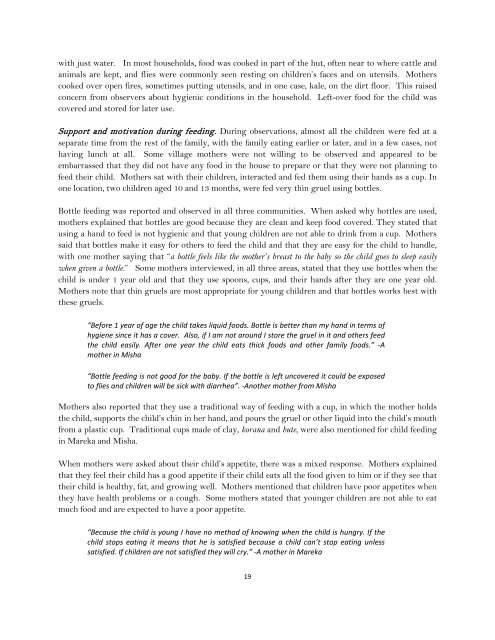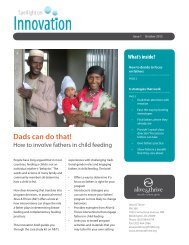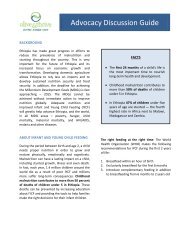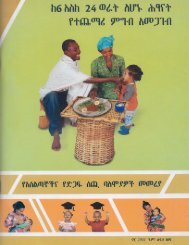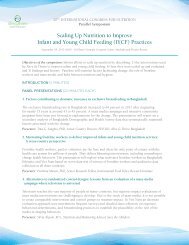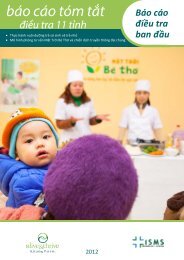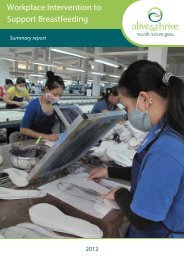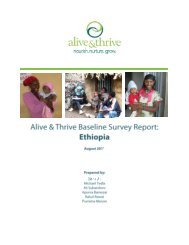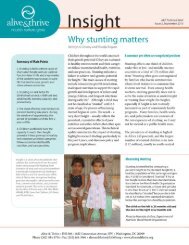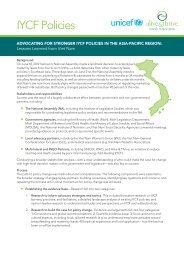IYCF Practices, Beliefs, and Influences in SNNP ... - Alive & Thrive
IYCF Practices, Beliefs, and Influences in SNNP ... - Alive & Thrive
IYCF Practices, Beliefs, and Influences in SNNP ... - Alive & Thrive
Create successful ePaper yourself
Turn your PDF publications into a flip-book with our unique Google optimized e-Paper software.
with just water. In most households, food was cooked <strong>in</strong> part of the hut, often near to where cattle <strong>and</strong>animals are kept, <strong>and</strong> flies were commonly seen rest<strong>in</strong>g on children’s faces <strong>and</strong> on utensils. Motherscooked over open fires, sometimes putt<strong>in</strong>g utensils, <strong>and</strong> <strong>in</strong> one case, kale, on the dirt floor. This raisedconcern from observers about hygienic conditions <strong>in</strong> the household. Left-over food for the child wascovered <strong>and</strong> stored for later use.Support <strong>and</strong> motivation dur<strong>in</strong>g feed<strong>in</strong>g. Dur<strong>in</strong>g observations, almost all the children were fed at aseparate time from the rest of the family, with the family eat<strong>in</strong>g earlier or later, <strong>and</strong> <strong>in</strong> a few cases, nothav<strong>in</strong>g lunch at all. Some village mothers were not will<strong>in</strong>g to be observed <strong>and</strong> appeared to beembarrassed that they did not have any food <strong>in</strong> the house to prepare or that they were not plann<strong>in</strong>g tofeed their child. Mothers sat with their children, <strong>in</strong>teracted <strong>and</strong> fed them us<strong>in</strong>g their h<strong>and</strong>s as a cup. Inone location, two children aged 10 <strong>and</strong> 13 months, were fed very th<strong>in</strong> gruel us<strong>in</strong>g bottles.Bottle feed<strong>in</strong>g was reported <strong>and</strong> observed <strong>in</strong> all three communities. When asked why bottles are used,mothers expla<strong>in</strong>ed that bottles are good because they are clean <strong>and</strong> keep food covered. They stated thatus<strong>in</strong>g a h<strong>and</strong> to feed is not hygienic <strong>and</strong> that young children are not able to dr<strong>in</strong>k from a cup. Motherssaid that bottles make it easy for others to feed the child <strong>and</strong> that they are easy for the child to h<strong>and</strong>le,with one mother say<strong>in</strong>g that “a bottle feels like the mother’s breast to the baby so the child goes to sleep easilywhen given a bottle.” Some mothers <strong>in</strong>terviewed, <strong>in</strong> all three areas, stated that they use bottles when thechild is under 1 year old <strong>and</strong> that they use spoons, cups, <strong>and</strong> their h<strong>and</strong>s after they are one year old.Mothers note that th<strong>in</strong> gruels are most appropriate for young children <strong>and</strong> that bottles works best withthese gruels.“Before 1 year of age the child takes liquid foods. Bottle is better than my h<strong>and</strong> <strong>in</strong> terms ofhygiene s<strong>in</strong>ce it has a cover. Also, if I am not around I store the gruel <strong>in</strong> it <strong>and</strong> others feedthe child easily. After one year the child eats thick foods <strong>and</strong> other family foods.” -Amother <strong>in</strong> Misha“Bottle feed<strong>in</strong>g is not good for the baby. If the bottle is left uncovered it could be exposedto flies <strong>and</strong> children will be sick with diarrhea”. -Another mother from MishaMothers also reported that they use a traditional way of feed<strong>in</strong>g with a cup, <strong>in</strong> which the mother holdsthe child, supports the child’s ch<strong>in</strong> <strong>in</strong> her h<strong>and</strong>, <strong>and</strong> pours the gruel or other liquid <strong>in</strong>to the child’s mouthfrom a plastic cup. Traditional cups made of clay, korana <strong>and</strong> bute, were also mentioned for child feed<strong>in</strong>g<strong>in</strong> Mareka <strong>and</strong> Misha.When mothers were asked about their child’s appetite, there was a mixed response. Mothers expla<strong>in</strong>edthat they feel their child has a good appetite if their child eats all the food given to him or if they see thattheir child is healthy, fat, <strong>and</strong> grow<strong>in</strong>g well. Mothers mentioned that children have poor appetites whenthey have health problems or a cough. Some mothers stated that younger children are not able to eatmuch food <strong>and</strong> are expected to have a poor appetite.“Because the child is young I have no method of know<strong>in</strong>g when the child is hungry. If thechild stops eat<strong>in</strong>g it means that he is satisfied because a child can’t stop eat<strong>in</strong>g unlesssatisfied. If children are not satisfied they will cry.” -A mother <strong>in</strong> Mareka19


